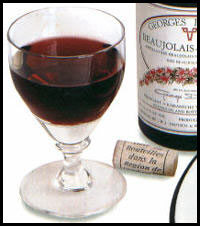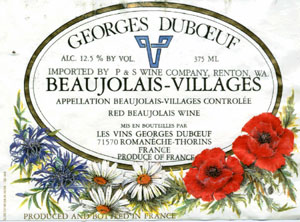![]()
![]()
If you enjoy this site, please check out mamster's new weblog, Roots and Grubs.
Wine: A Starter Kit
by Matthew Amster-Burton
October 27, 1999
 Okay, I admit it. I started drinking wine
because of peer pressure.
Okay, I admit it. I started drinking wine
because of peer pressure.
No, no, I don't mean drunken schoolmates collared me after class and drained a box of Franzia into my gullet, although that probably would have been an improvement over the American beer we did drink in high school. I mean that when I became interested in food, I quickly learned that to the Italians and the French, who are said to know a thing or two about these things, a meal isn't a meal without the interplay between food and wine. (The other culinary tradition I most admire, the Chinese, doesn't play up wine with meals, but since they already have the world's best food, this can be forgiven.)
They were right. Wine and food are made for each other. The problem, and the reason I wasn't drinking wine before, is that the most popular wines in America (Franzia excluded) are offputting for beginning wine drinkers and very difficult to match with food. How often have you had a California cabernet or chardonnay that didn't seem to do anything for your food? It's not that the wine was bad, but these are big, complex wines that to most palates and with most foods just taste strong and bitter. Enough experiences with these behemoths is enough to turn anyone back to Sprite.
Wine drinking should be fun. We do it--or should--because the taste makes your food more enjoyable and the alcohol makes you feel good. It doesn't hurt that the evidence keeps piling up that moderate drinking is good for your heart. Indeed, 5-6 drinks a week for men (fewer for women) cuts your risk of heart attack by up to 80 percent, especially if you're diabetic, according to the most recent research reported in JAMA. The debate rages on, however, over whether wine offers any special benefits over other drinks. (Check with your doctor about alcohol consumption if you're taking any kind of medication, and for God's sake designate a driver.)
So with that in mind, here are four wines that are versatile, inexpensive, and fun to drink. I've chosen two red, one white, and one sparkling in the hopes that you'll look beyond the usual suspects next time you shell out for a bottle.
1. Beaujolais-Villages
 When wine critics get to talking about this wine,
you'll hear phrases like "supple," "slurpable," "a great quaffer,"
and "a party in a bottle." Makes you want to reach for the
corkscrew right now, doesn't it? Me neither. So let's try this:
Beaujolais is a fruity, young red wine from Burgundy that goes well
with all sorts of food, including fish. It's not at all tannic,
which means none of that bitterness that grabs the back of your
throat. I can't think of any savory dish that wouldn't go well with
a bottle of Beaujolais. It's meant to be drunk young, so buy the
youngest vintage you can find--right now that's the 1998, and the
1999 will be available in just a few months. Unlike most red wines,
this one should be served lightly chilled. The largest Beaujolais
producer is Georges
Duboeuf, and his is just fine. Expect to spend $7-$10.
When wine critics get to talking about this wine,
you'll hear phrases like "supple," "slurpable," "a great quaffer,"
and "a party in a bottle." Makes you want to reach for the
corkscrew right now, doesn't it? Me neither. So let's try this:
Beaujolais is a fruity, young red wine from Burgundy that goes well
with all sorts of food, including fish. It's not at all tannic,
which means none of that bitterness that grabs the back of your
throat. I can't think of any savory dish that wouldn't go well with
a bottle of Beaujolais. It's meant to be drunk young, so buy the
youngest vintage you can find--right now that's the 1998, and the
1999 will be available in just a few months. Unlike most red wines,
this one should be served lightly chilled. The largest Beaujolais
producer is Georges
Duboeuf, and his is just fine. Expect to spend $7-$10.
2. Barbera d'Alba
The wines of Italy are often overlooked, and I think it's partly Italy's fault. Italy is by far the world's largest wine producer, with thousands of vineyards bottling scads of different grapes and styles of wine. This is good. However, this embarrassment of riches makes it hard to keep track of all the options, and the government of Italy hasn't done a good job of making regional designations like France has. As a result, while you can probably name a dozen French wines, I defy you to remember more than a couple Italian wines beyond Chianti and Asti Spumante (which isn't even called Asti Spumante anymore--they dropped the Spumante, but did they tell you? Hmm?).
On the upside, Italian wines are mostly cheap and with a little guidance, you can take home a bottle with confidence. Here is the guidance. Grab a bottle of Barbera d'Alba, two or three years old. It'll run you around $15. It's a much fuller-bodied red wine than the Beaujolais, but still relatively low in tannins. Barbera's real gift is how well it goes with spaghetti sauce. Forget Chianti--this is a killer combination. Open up a can of Muir Glen diced tomatoes and bottle of Barbera, start boiling some water and tearing some basil, and you're most of the way to a great meal.
3. Washington Riesling
I love German Riesling. What I don't like is choosing a German Riesling. German wine labels deserve their reputation as impenetrable: they cover the type of grape, the time of the season when it was harvested, the vintage year, the quality designation, the vineyard, the producer, the geographic area, and the name of the current Chancellor's mistress. I could give you a short list of German Rieslings to look for, but who wants to tramp all over town in search of a Kabinett Halbtrocken?
So buy American. Specifically, buy a Riesling from my backyard, Washington State. I think ours are the best Rieslings grown outside Germany, and they're plenty cheap. A delicious Covey Run will set you back less than $8. It's a white wine that ranges from dry to fairly sweet (late-harvest Riesling, which is not what I'm recommending here, is very sweet), is often just the slightest bit bubbly, and pairs well with shellfish and other fish, salami, lots of vegetables, and even spicy foods. As you know, my favorite restaurant is Thai, and most of their food is spicy enough to turn wine into water. But Riesling resists the transformation by being just tangy and fruity enough to retain its refreshing personality.
4. Moscato d'Asti
In October of 1998, we had a family dinner at Campagna, a northern Italian restaurant near the Flatiron Building in Manhattan. It is a meal I will never forget. I had the Rigatoni Brunelleschi, homemade pasta sauced with a winy beef stew, the best meat sauce you could ask for. After dinner, our waiter surprised us with a complimentary plate of cookies and teardrop flutes of a pale sparkling wine. It was exquisite, sweet and appley, a soft fog floating above the glass. Laurie, who isn't much of a wine drinker, drained her glass and finished my mother's. Our receipt revealed it to be a Moscato d'Asti.
Some occasions call for bubbly. You can't go wrong with
Champagne, of course, but you can't pay much less than $30 for a
bottle of something everyone has had before. California and Spanish
sparklers are a crapshoot. Next time you're celebrating, uncork a
Moscato d'Asti, which you can find for under $15. It's a relative
of the bestselling Asti Spumante (which, as noted above, is now
just called Asti, but who are they kidding?), but a richer, sexier
relative.![]()
![]()